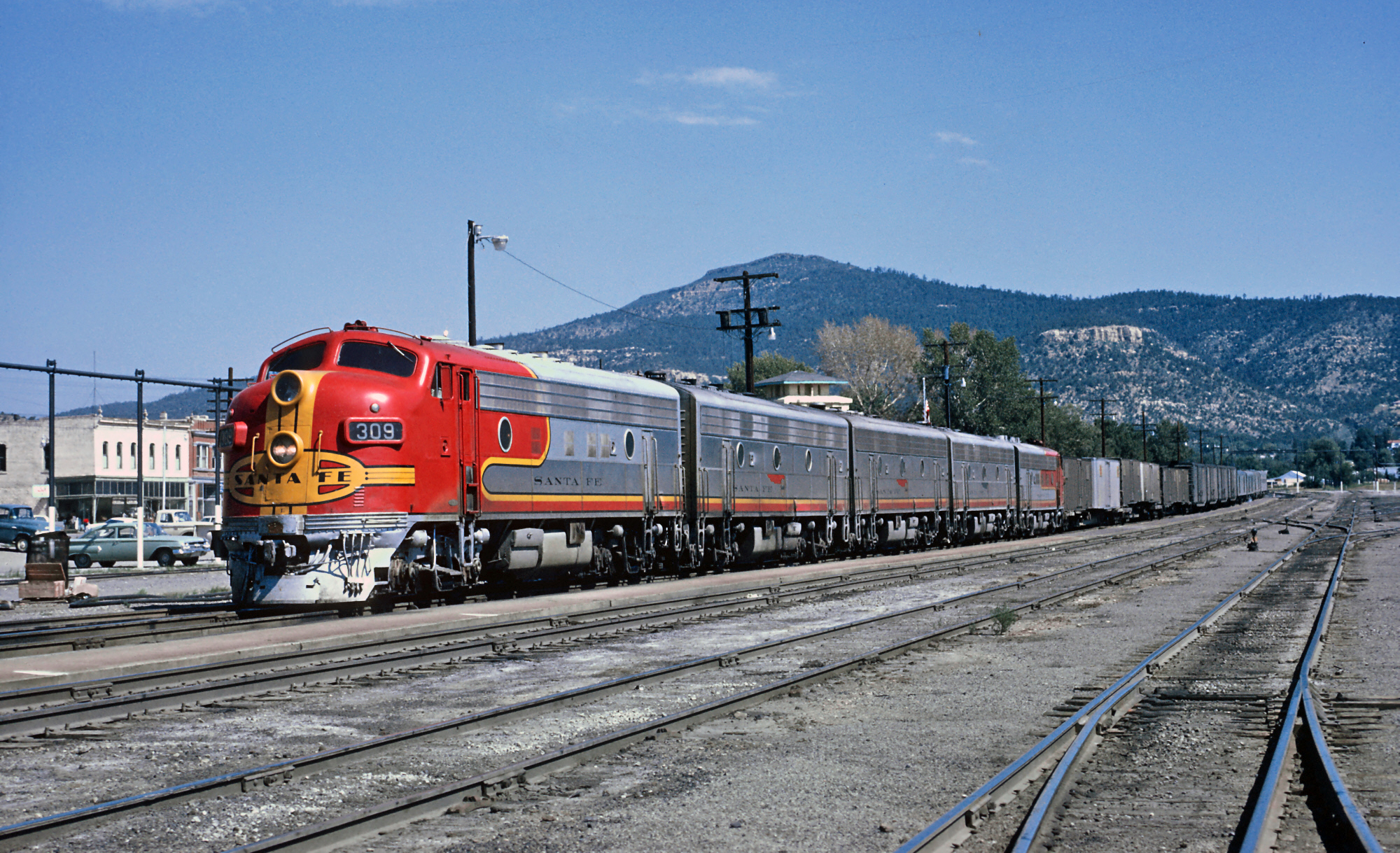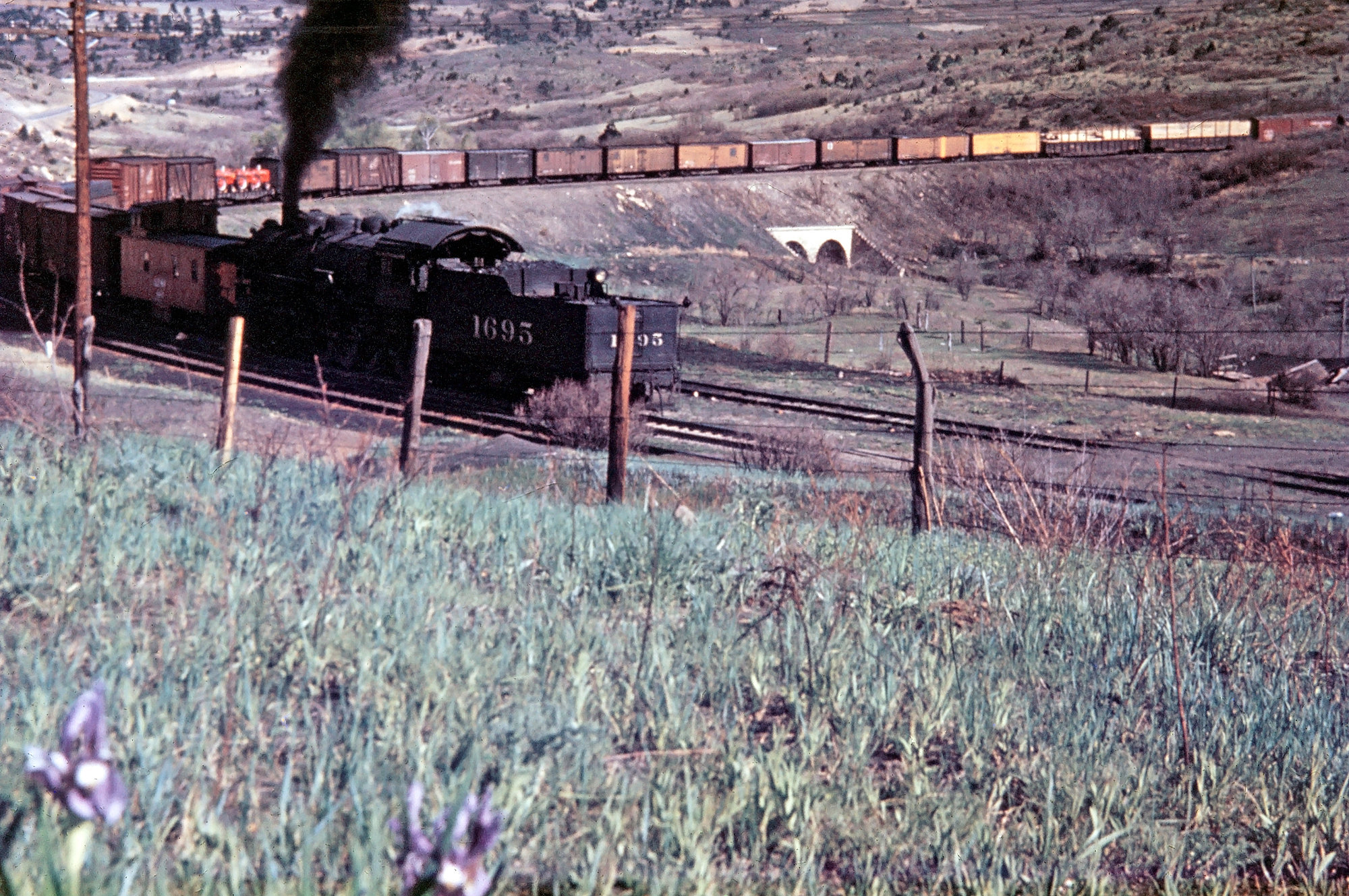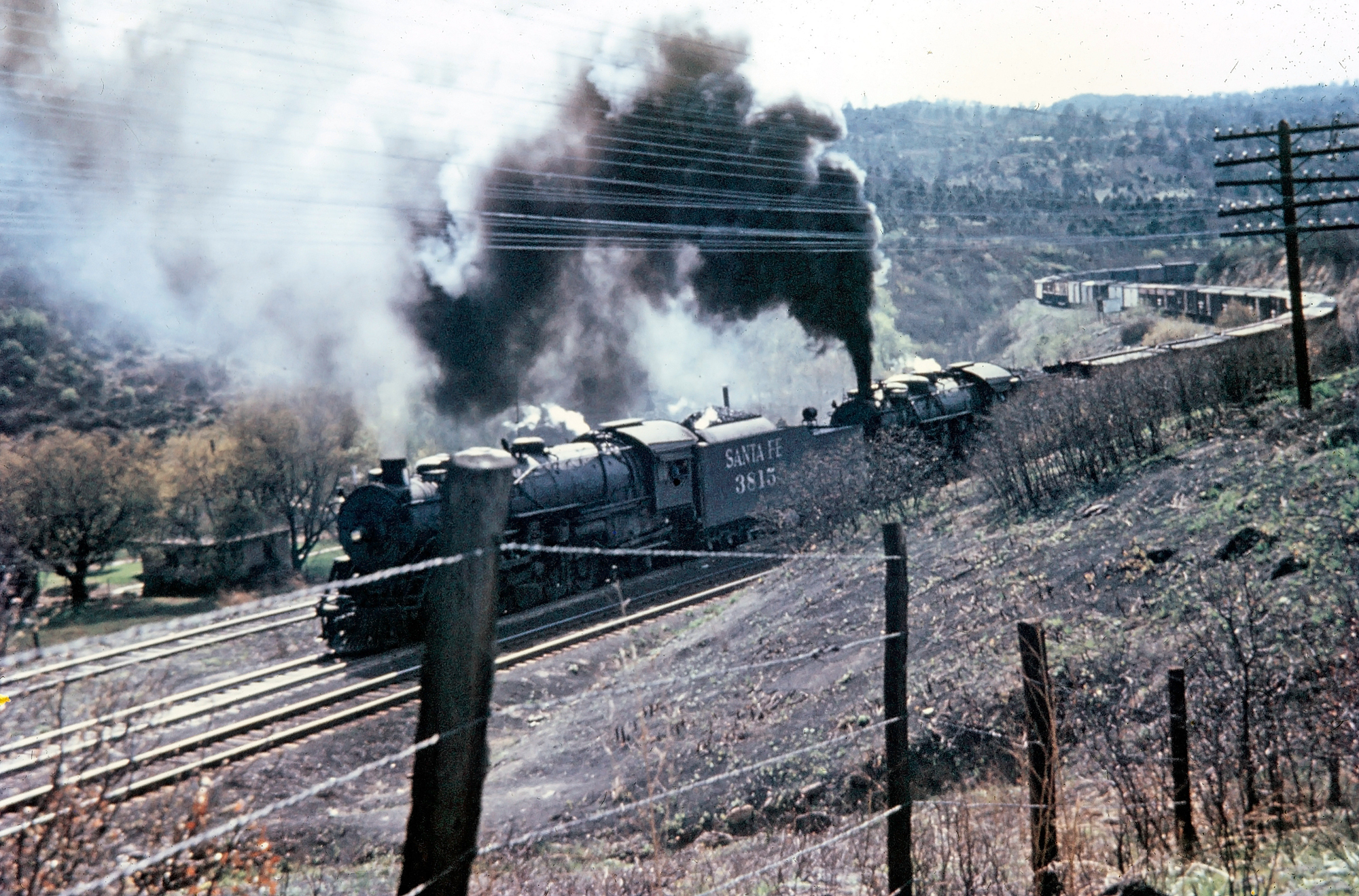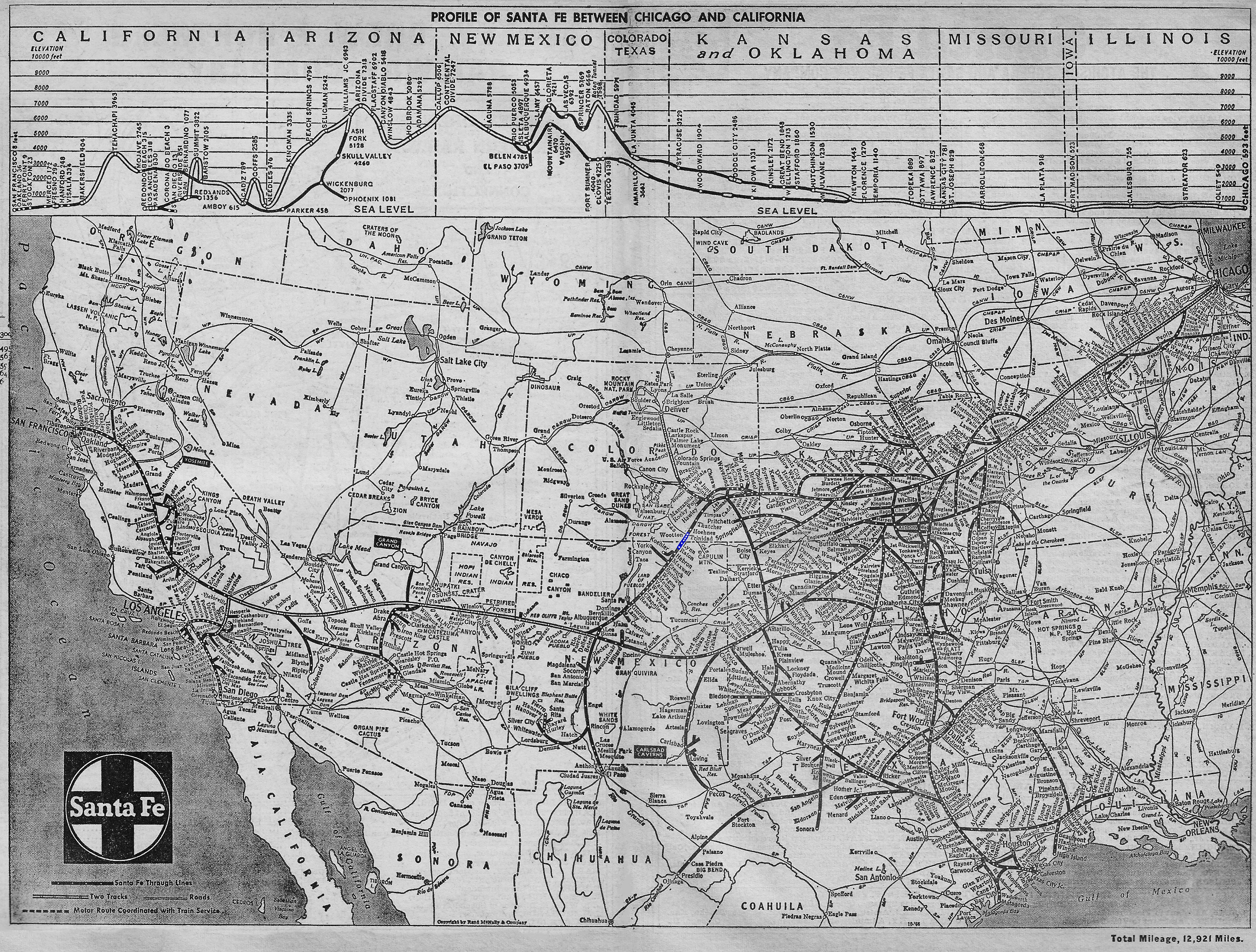- Home ›
- Landmarks ›
- Raton Pass
Raton Pass (New Mexico): Map, Route, History
Last revised: February 25, 2025
By: Adam Burns
Raton Pass is a mountain pass located in the Sangre de Cristo Mountains on the border of Colorado and New Mexico in the United States. It is a historically significant landmark, serving as a primary route for the Santa Fe Trail in the 19th century.
The pass is known for its steep grades, making it a challenging route for early settlers and later for the Santa Fe's main line. Today, the pass is also home to Interstate 25.
During the early 20th century the AT&SF completed the Belen Cutoff to the south which bypassed the mountains and cut across the northern plains of Texas.
The result of this work allowed for easier grades, faster transit times, and more efficient operations. Nevertheless, Raton remained an important corridor for years despite being listed as the steepest main line in the west.
Today, Raton sees less freight traffic from its peak years but it is currently still operated by successor BNSF Railway.
Photos
 Roger Puta photographed Santa Fe F7A #309-L ahead of train #23, the westbound 'Grand Canyon,' at Raton, New Mexico on August 19, 1967.
Roger Puta photographed Santa Fe F7A #309-L ahead of train #23, the westbound 'Grand Canyon,' at Raton, New Mexico on August 19, 1967.History
One of the classic mountain rail grades is Santa Fe's Raton Pass. Located near the border of northeastern New Mexico and southern Colorado, the pass is home to the AT&SF's original transcontinental main line.
To acquire the pass required a fight with the Denver & Rio Grande, one of many duels between the two railroads during that time. The exploits of this war is detailed in Keith Bryant, Jr.'s excellent book, "History Of The Atchison, Topeka & Santa Fe Railway."
During May of 1869 the Transcontinental Railroad was completed opening the west to trade and development. Following the completion of this line new railroads began spreading throughout the region, which included the Santa Fe and Denver & Rio Grande Railway.
The AT&SF had been building west from Topeka, Kansas since 1860 and the D&RG was chartered a decade later in 1870 hoping to connect Denver with El Paso, Texas and eventually Mexico.
On February 16, 1876 the Santa Fe reached La Junta, Colorado while the D&RG had arrived at Pueblo four years prior. At the time the pass was owned by Richens Lacy "Uncle Dick" Wootton, who had lived in the region since the 1850s.
Railroad War
William Barstow Strong became Santa Fe's president in 1877 and he immediately went to war with General William Palmer, owner of the D&RG, for control of the 7,834-foot Raton Pass.
After the Strong caught wind of Palmer's intentions to build through the pass he sent company engineer Albert Robinson and Location Engineer Ray Morley, using a D&RG train no less, to El Moro near Trinidad, Colorado where they would scout their own route.
In the process they hoped to gain Wootton's permission for first rights to build a rail line over the pass. At the time "Uncle Dick" owned a 27-mile toll road over Raton. His home was also based here as well as a small hotel.
Morley subsequently befriend Wootton, and he agreed to sell his enterprise to the Santa Fe. When D&RG's team showed up to claim it the pass for themselves he helped turn away the invaders.
 Santa Fe 2-10-2 #1695 (a 1912 product of Baldwin) works helper service over Raton Pass as the big engine shoves on the rear of a long manifest freight, circa 1954. Ed Olsen photo. American-Rails.com collection.
Santa Fe 2-10-2 #1695 (a 1912 product of Baldwin) works helper service over Raton Pass as the big engine shoves on the rear of a long manifest freight, circa 1954. Ed Olsen photo. American-Rails.com collection.Ultimately, the D&RG gave up on its intentions to continue building south and instead constructed a line to the west over Tennessee Pass through Colorado's Royal Gorge.
While the Santa Fe may acquired the rights to Raton it was still in the difficult position of actually building a railroad over the pass.
The AT&SF originally completed a line over the mountain in 1878, a temporary and torturous route that featured switchbacks, 6% grades, and curves as sharp as 16 degrees.
Completion
In 1879 crews were able to finish the 2,041-foot tunnel over Raton, which eliminated the switchbacks and greatly reduced ruling grades. However, the AT&SF was still forced to deal with grades reaching as high as 3.5% in New Mexico and 4% in Colorado.
After finally conquering Raton, Santa Fe continued eastward through New Mexico and eventually reached Arizona and much of California. All of this effort was carried out under Strong, who is still considered one of the railroad's greatest presidents.
Years later the railroad double-tracked much of Raton and constructed a second, 2,787-foot bore through the mountain that featured grades of just 0.158%.
For all of the improvements, Raton was always an operational headache for the Santa Fe, as was any main line that featured grades above 3%.
Route Map
In 1907 the AT&SF opened Belen Cutoff, a 200+ mile main line that cut across the open plains of eastern New Mexico and the Northern Panhandle of Texas.
This new route diverted most of the railroad's transcontinental traffic off of Raton. However, the original line continued to see several trains per day including the crack Super Chief and El Capitan as well as several coal trains from nearby mines.
During the steam era one could regularly witness double-headed 2-8-8-2s and 2-10-2s tackling the grades either moving freights or assisting passenger consists.
As the years have passed train movements have ebbed and flowed over Raton Pass. Today, it has lost much of the local coal movements that once moved steadily out of the region. Additionally, much of the priority traffic has been picked up over Belen and the Transcon route.
 A pair of Santa Fe locomotives, lead by 2-10-2 #3815, double-head a long freight over Raton Pass, circa 1950. Ed Olsen photo. American-Rails.com collection.
A pair of Santa Fe locomotives, lead by 2-10-2 #3815, double-head a long freight over Raton Pass, circa 1950. Ed Olsen photo. American-Rails.com collection.Today
Still, Raton refuses to give up the ghost and today acts primarily as a relief valve occasionally seeing hot-shot movements such as "Z"-symbolled intermodals or United Parcel Service (UPS) pre-blocked movements.
There is also Amtrak's Southwest Chief which continues to use the line. Most other trains passing over Raton are strings of empty coal hoppers or "bare-table" well cars (intermodal).
It is interesting to wonder what the future holds for the country's
steepest main line still in operation although it appears that for now
we will continue to see the latest locomotives tackle Santa Fe's
original transcontinental route to the west coast.
(Thanks to "Raton Panorama" from the August, 1946 issue of Trains, "Crown Of The Santa Fe" by William Diven from the February, 1997 issue of Trains, and "Raton Passed" by William Diven from the November, 2005 issue of Trains as primary references for this article.)
Additional Sources
- Bryant, Jr. Keith L. History Of The Atchison, Topeka & Santa Fe Railway. New York: Macmillan Publishing Company, 1974.
- Glischinski, Steve. Santa Fe Railway. St. Paul: Voyageur Press, 2008.
- Yenne, Bill. Santa Fe Chiefs. St. Paul: TLC Publishing Company, 2005.
Recent Articles
-
A Pennsylvania Christmas Train Ride In Hollidaysburg!
Nov 15, 25 11:22 PM
Today, the Everett Railroad offers scenic excursions, hands-on steam experiences, and one of the state’s most popular Christmas trains: the Santa Express. -
A Wisconsin Christmas Train Ride In Trego!
Nov 15, 25 11:04 PM
Among the Wisconsin Great Northern's most popular excursions are its Christmas season offerings: the family-friendly Santa Pizza Train and the adults-only Holiday Wine Train. -
Northern Central Railway: PRR's Baltimore-Harrisburg Line
Nov 15, 25 10:36 PM
The Northern Central Railway has worn many faces over two centuries: ambitious antebellum trunk line, Civil War lifeline, proud Pennsylvania Railroad main line, and finally a quiet rail-trail and heri…




